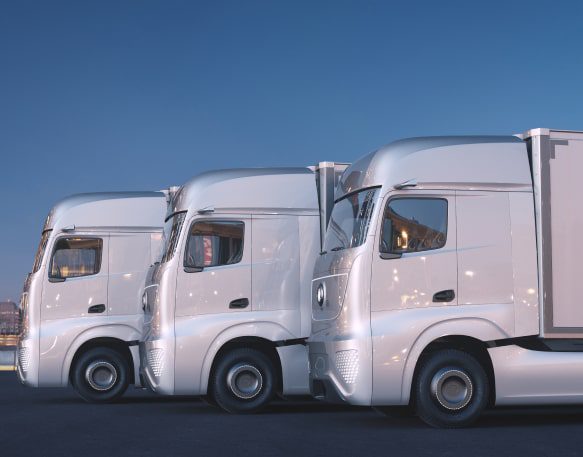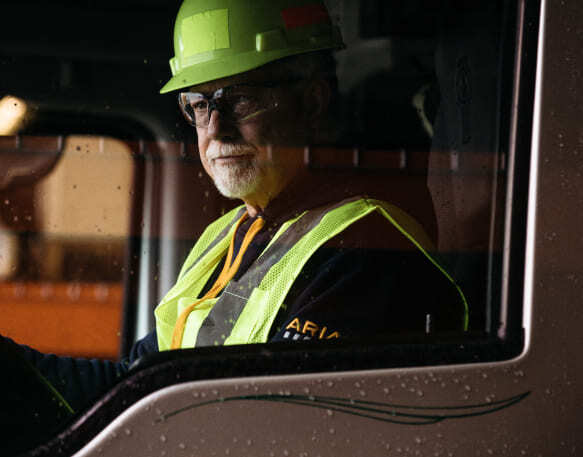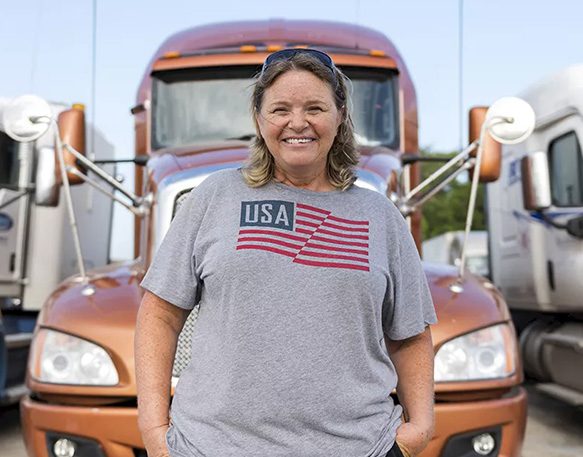The trucking industry is an ever-evolving field, and technology is bringing many sweeping changes to how carriers will operate in the future. A lot of those changes are exciting, but some can seem a little daunting. Foremost among those for many carriers and owner-operators is the rise of self-driving trucks.
There’s no doubt that the importance of trucking isn’t going anywhere. As of 2020, approximately 3.5 million truck drivers carry over 70% of the goods shipped in the US. This is equal to 10 billion tons of freight, resulting in $732 billion in gross freight revenues. In addition, the pandemic increased e-commerce sales by approximately $219 billion between 2020 and 2021, and forecasts predict that e-commerce will grow from a $5.5 trillion market to over $7 trillion by 2025.
With demand increasing, self-driving trucks seem like an obvious path forward for the future of trucking. However, there are many concerns that automated trucks will replace truck driver jobs, with many anxiously wondering when will self-driving trucks take over. But a deeper look into how the industry is evolving reveals a much more nuanced perspective and a more hopeful outlook for truck drivers.
At DAT, we know how important it is for carriers and owner-operators to keep a pulse on the future of the trucking industry. We’re here to help you do just that. Let’s go through everything you’ll need to know to prepare yourself for the arrival of self-driving trucks.
How do self-driving trucks work?
Self-driving trucks use a variety of sensors and AI-based software to control and navigate with little-to-no human input. Sensors help automated trucks locate the positions of other vehicles, read traffic signals and road signs, measure distances and detect road edges, and much more. Machine learning systems and AI algorithms will then take that data and use it to make the best decisions while driving. This means a self-driving truck would potentially be able to safely change lanes in order to pass a slower vehicle, and could even go as far as meaning that the truck is capable of loading and unloading automatically.
The biggest benefits of self-driving trucks are the improvements to efficiency and productivity that they present. Regulations limit human truck drivers to eight hours of working before having to take a break, and drivers can only work for a total of 11 hours a day. On the other hand, a self-driving truck could operate for as much as 17 hours a day.
But that’s not the only advantage. Autonomous trucks can also help make the roads safer by improving driving performance and predictability, automating processes like acceleration, regulating speed and braking, and more. This is a huge advantage given how many car accidents occur every year.
Despite these promising benefits, we’re still nowhere near wide adoption of self-driving cars. Much of the technology and regulation required for industry-wide adoption of self-driving trucks are still a ways out, and even when these trucks do become more widely available, human truck drivers will still be needed to help operate them, meaning they will not offer a complete replacement to truckers.
When will self-driving trucks take over?
The short answer is never — there will always be drivers needed in some circumstances — but there’s no doubt that we will see a rise in self-driving cars over the coming years. The National Highway Traffic Safety Administration (NHTSA) breaks down autonomous driving into six levels:
- Level 0: No automation, fully human-operated
- Level 1: Driver-assisted automation, such as cruise control
- Level 2: Partial automation, includes features like corrective steering and automatic braking
- Level 3: Conditional automation, meaning the vehicle operates autonomously, but a driver must still be present to take over if needed
- Level 4: Vehicle can perform all functions automatically under certain conditions, a driver should be present, but is mostly optional
- Level 5: Driver is fully optional and the vehicle can perform all functions autonomously
As it stands, many of the main players who are developing self-driving trucks are operating on Level 4, meaning there is still some need for a driver to at least be present, since there will still be conditions where the automated trucks can’t function properly.
But even with many innovative and ambitious companies aiming for Level 5 automation, there’s no guarantee that no drivers will be involved at any stage. That decision will depend on regulators, and on the technology that will enable shippers and carriers across the industry to safely adopt it.
Who are the major players in self-driving trucks?
Here are just a few of the main companies innovating with self-driving trucks and defining the future of the trucking industry:
- Daimler: The parent company of Mercedes-Benz, Daimler, was one of the first entrants into the self-driving truck space. They are now a leading OEM for Level 4 autonomous truck development, setting the benchmark for redundant scalable truck platforms for autonomous trucks. Daimler also has a subsidiary company called Torc Robotics, that is also well known in the space as a pioneer in self-driving truck technology.
- Plus: What makes Plus stand out from other self-driving truck companies is that their focus is on retrofitting existing trucks and upfitting new trucks rather than building trucks from scratch. Plus acknowledges that many carriers and owner-operators are not in the position to purchase self-driving trucks, making this a smart option for truckers who are thinking about integrating automation into their existing fleets.
- TuSimple: This company puts a particular focus on creating networks of routes and depots to facilitate its self-driving trucks and make moving freight easier. Combined with TuSimple’s self-driving platform, these networks can help shippers and carriers greatly improve their efficiency.
- Aurora: Aurora describes itself as an autonomous Driver-as-a-Service business. Their subscription service lets carriers supplement their existing fleets with safe and efficient autonomous drivers, allowing trucking companies to scale their operations to keep up with demand without having to replace parts of their existing fleets.
What are the risks of self-driving trucks?
Even as it seems that a number of major players are planning to bring their autonomous systems and trucks to the market within a few years, there are still challenges that must be addressed before we can possibly truly see widespread use of Level 4 and 5 autonomous trucks to haul loads.
One of the major pain points involves the sensors used to gather the data AI systems in autonomous vehicles need to process in order to make these vehicles work. Current technological limits mean that the accuracy of the AI systems in autonomous trucks drops drastically when in densely populated areas like cities and urban environments, or when dealing with harsh weather conditions — both situations that freight trucks encounter frequently.
Given those limitations, the reality is that even the best and safest self-driving trucks will require a human driver to operate the vehicle through these areas manually, whether they are actually in the cab or if controlling the truck remotely, an approach that some tech companies are beginning to utilize.
Of course, this technology is something that self-driving vehicle companies are working hard to improve. Whether or not the technology ultimately becomes safe enough to warrant industry-wide adoption of self-driving trucks, there may still be a need for drivers. It will ultimately be left up to the regulators to decide how companies should approach the presence of human drivers for safety purposes. Even if they do decide to allow self-driving vehicles without drivers, fleet operators themselves will still have discretion over whether human drivers are needed to ensure everything operates smoothly.
Will truck drivers be out of a job?
Will self-driving trucks replace drivers and owner-operators? That’s the big question in the industry right now. The short answer is no! The long answer is that the role of the truck driver may evolve as self-driving technology becomes the norm even if it doesn’t disappear completely. As previously mentioned, even the highest levels of autonomous trucks will very likely still need drivers in place for safety reasons.
In many instances, even if the trucks don’t have drivers in the cab, truck drivers will still be needed to remotely control self-driving trucks through certain areas like crowded urban areas or spots where harsh weather conditions hit. And while some trucks may aim to automate the loading and unloading process, there will still be many situations in which drivers will be required to aid with that process as usual.
The role of the truck driver may also become more of an administrative role. With self-driving trucks being so much more efficient, truck drivers and owner-operators can spend more time managing their businesses more efficiently than they could if stuck behind the wheel all day.
And, of course, regulators and insurers will have a significant say in whether human drivers are still needed. For safety reasons, it certainly seems like they are. Even if it is a bit different from the traditional role they’ve always filled, there’s no doubt truck drivers are still needed.
What does the future of the industry look like?
In regards to self-driving trucks, the hybrid role of the truck driver maintaining and operating the autonomous vehicle when necessary while simultaneously shifting to different responsibilities will become very commonplace in the future of the trucking industry.
A lot of the discussion around the future of the trucking industry is also centered around the environmental impact of motor vehicles. Many self-driving truck companies claim that their technology helps reduce emissions by improving fuel efficiency. We are also seeing a rise in electric trucks in conjunction with self-driving technologies, though both electric trucks and alternative fuels are years out from being efficient or cost-effective enough for the industry to adopt them broadly.
Overall, the future of the trucking industry is likely not a question of when will self-driving trucks take over, but rather a question of how will the current trucking workforce evolve alongside self-driving trucks as they develop further. The reality is, we will always need experienced and knowledgeable truck drivers populating the industry no matter whether trucks are driving themselves or not. As self-driving trucks evolve, we will see what exactly their roles look like.
Let DAT help you navigate the future of trucking
For carriers and owner-operators who want to grow their business for the long haul alongside whatever technological changes may come, DAT’s carrier services are here to help make the rest of the job seamless and efficient. Find freight with the best rates quickly and easily with the DAT One Load Board. You can gain access to factoring and fuel cards, along with plenty of other features that help make your trucking business a well-oiled machine. See how DAT can help your business succeed!
Find freight with the DAT load board!
Whether your trucks are driven by humans or machines, you’ll still need to find loads. Enter the DAT load board.
Not only does the DAT load board have millions of loads to filter through, but it also offers accurate insights into brokers and current rates. Subscribe today to find freight!




